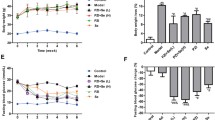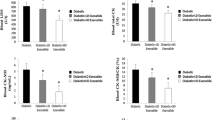Abstract
Sodium selenate, administered intraperitoneally (i.p.), resulted in an improvement in glucose tolerance in treated diabetic rats. Fed rat plasma glucose levels were reduced by selenate treatment in streptozotocin diabetic rats. The lowest values of blood glucose were reached within 3 weeks of beginning the treatment. Food and fluid consumption was reduced in treated compared to untreated diabetic rats. Diabetic treated rats did not release insulin in response to a glucose challenge and insulin release in response to a challenge was markedly reduced in control treated rats. Assessment of heart function using a working heart apparatus showed that treated diabetic rats with improved blood glucose levels had normal heart function at 8 weeks of diabetes in contrast to hearts from non-treated diabetics. This study extends previous observations on the in vivo insulin-like effects of sodium selenate.
Similar content being viewed by others
References
Ezaki O: The insulin-like effects of sodium selenate in rat adipocytes. J Biol Chem 265: 1124–28, 1990
McNeill JH, Delgatty HLM, Battell ML: Insulinlike effects of sodium selenate in streptozotocin diabetic rats. Diabetes 40: 1675–78, 1991
Becker DJ, Reul B, Ozcelikay AT, Buchet JP, Henquin J-C, Brichard SM: Oral selenate improves glucose homeostasis and partly reverses abnormal expression of liver glycolytic and gluconeogenic enzymes in diabetic rats. Diabetologia 39: 3–11, 1996
Ghosh R, Mukherjee B, Chatterjee M: A novel effect of selenium on streptozotocin-induced diabetic mice. Diabetes Res 25: 165–171, 1994
Heyliger CE, Tahiliani AG, McNeill JH: Effect of vanadate on elevated blood glucose and depressed cardiac performance of diabetic rats. Science 227: 1474–1477, 1985
Ramanadham S, Mongold JJ, Brownsey RW, Cros GH, McNeill JH: Oral vanadyl sulphate in treatment of diabetes mellitus in rats. Am J Physiol 257: H904–H911, 1989
Ramanadham S, Brownsey RW, Cros GH, Mongold JJ, McNeill JH: Sustained prevention of myocardial and metabolic abnormalities in diabetic rats following withdrawal from oral vanadyl treatment. Metabolism 38: 1022–1028, 1989
Strout HV, Vicario PP, Biswas C, Saperstein R, Brady EJ, Pilch PF, Berger J: Vanadate treatment of streptozotocin diabetic rats restores expression of the insulin-responsive glucose transporter in skeletal muscle. Endocrinology 126: 2728–2732, 1990
Brichard SM, Okitolonda W, Henquin JC: Long term improvement in glucose homeostasis by vanadate treatment in diabetic rats. Endocrinology 123: 2048–2053,1988
Meyerovitch J, Farfel Z, Sack J, Shechter Y: Oral administration of vanadate normalizes blood glucose levels in streptozotocin-treated rats. Characterization and mode of action. J Biol Chem 262: 6658–6662, 1987
Rotruck JT, Pope AL, Ganther HE, Swanson AB, Hafeman DG, Hoekstra WG: Selenium: biochemical role as a component of glutathione peroxidase. Science 179: 588–590, 1973
World Health Organization: Selenium Environmental Health Criteria 58: World Health Organization Geneva, 1987
Chen X, Yang G, Chen J, Chen X, Wen Z, Ge X: Studies on the relations of selenium and Keshan disease. Biol Trace Elem Res 2: 91–107, 1980
Hawkes WC, Wilhelmsen EC, Tappel AL: Abundance and tissue distribution of selenocystine-containing proteins in the rat. J Inorg Biochem 23: 77–92, 1985
Behne D Kyriakopoulos A Meinhold H Kohrle J: Identification of type 1 iodothyronine 5′-deiodinase as a selenoenzyme. Biochem Biophys Res Comm 173: 1143–1149, 1990
Behne D Kyriakopoulos A: Effects of dietary selenium on the tissue concentrations of type 1 iodothyronine 5′-deiodinase and other selenoproteins. Am J Clin Nutr Suppl 57: 310S–312S, 1993
Kannel WB, McGee DL: Diabetes and cardiovascular risk factors. The Framingham Study. Circulation 59: 8–13, 1979
Opie LH: Effect of fatty acid on contractility and rhythm of the heart. Nature (London) 227: 1055–1066, 1970
Skipp JC, Menahan LA, Crass III MF, Chaudhuri SN: Heart triglycerides in health and disease. In: NS Dhalla (ed). Recent Advances in Studies on Cardiac Structure and Metabolism. Vol 3., University Park Press, Baltimore, MD, 1973, pp 179–204
Vadlamudi RVSV, Rodgers RL, McNeill JH: The effect of chronic alloxan-and streptozotocin-induced diabetes on isolated rat heart performance. Can J Physiol Pharmacol 60: 902–911, 1982
Tahiliani AG, Vadlamudi RVSV, McNeill JH: Prevention and reversal of altered myocardial function in diabetic rats by insulin treatment. Can J Physiol Pharmacol 61: 516–523, 1983
Turan B, Dalay N, Afrasyap L, Delilbasi E, Sengun Z, Sayal A, Isimer A: The effects of selenium supplementation on antioxidative enzyme activities and plasma and erythrocyte selenium levels. Acta Physiol Hung 81: 87–93, 1993
Zhong G-G, Jiang Y, Li ZB, Zhang BG, Zhang WJ, Yue G: Protective action of selenium and manganese on xanthine and xanthine oxidase induced oxidative damage to cultured heart cells. Chin Med J 103: 735–742.1990
Halverson AW, Palmer IS, Guss PL: Toxicity of selenium to post weanling rats. Toxicol Appl Pharmacol 9: 477–484, 1966
Tinsley IJ, Harr JR, Bone JF, Weswig PH, Yamamoto RS: Selenium toxicity in rats. I. Growth and longevity. In: OH Muth, JE Oldfield and PH Weswig (eds). Selenium in Biomedicine. The Avi Publishing Co. Inc., Westport, Conn., 1967, pp 141–152
Jacobs MM, Forst C: Toxicological effects of sodium selenite in Sprague Dawley rats. J Toxicol Environ Health 8: 575–585, 1981
Franke KW, Moxon AL: A comparison of the minimum fatal dose of selenium, tellurium, arsenic, and vanadium. J Pharmacol Exp Ther 58: 454–459, 1936
Schroeder HA Mitchener M: Selenium and tellurium in rats: effects on growth, survival, and tumors. J Nutr 101: 1531–1540, 1971
Smith MI, Westfall BB, Stohlman EF Jr: The elimination of selenium and its distribution in the tissues. U.S. Publ Health Rep 52: 1171–1177, 1937
Thorlacius-Ussing O: Selenium induced growth retardation. Histochemical and endocrinological studies on the anterior pituitaries of selenium treated rats. Danish Med Bull 37: 347–358, 1990
Tolman EI, Barris E, Burns M, Pansini R, Partridge R: Effects of vanadium on glucose metabolism in vitro. Life Sci 25: 1159–1165, 1979
Furnsinn C, Leitner G, Roden M, Osterode W, Waldhausl W: Improved glucose tolerance by acute vanadate but not selenate exposure in genetically obese rats (fa/fa). Intern J Obesity 19: 458–463, 1995
Tamura S, Brown TA, Dubler RE, Larner J: Insulin-like effects of vanadate on adipocyte glycogen synthase and on phosphorylation of 95,000 dalton subunit of insulin receptor. Biochem Biophys Res Comm 113: 80–86, 1983
Shisheva A Shechter Y: Role of cytosolic tyrosine kinase in mediating insulinlike actions of vanadate in rat adipocytes. J Biol Chem 268: 6463–6469, 1993
Rodrigues BB, McNeill JH: Cardiac function in spontaneously hypertensive diabetic rats. Am J Physiol 251: H571–H580, 1986
Rodrigues BB, Goyal RK, McNeill JH: Effects of hydralazine on streptozotocin induced diabetic rats: Prevention of hyperlipidemia and improvement in cardiac function. J Pharmacol Exp Ther 237: 292– 299, 1986
Koehler H, Peters H-J, Pankau H, Duck H-J: Selenium in cardiology and angiology. Biol Trace Elem Res 15: 157–167, 1988
Konz K-H, Haap M, Hill KE, Burk RF, Walsh RA: Diastolic dysfunction of perfused rat hearts induced by hydrogen peroxide. Protective effect of selenium. J Mol Cell Cardiol 21: 789–795, 1989
Author information
Authors and Affiliations
Rights and permissions
About this article
Cite this article
Battell, M.L., Delgatty, H.L. & McNeill, J.H. Sodium selenate corrects glucose tolerance and heart function in STZ diabetic rats. Mol Cell Biochem 179, 27–34 (1998). https://doi.org/10.1023/A:1006819227506
Issue Date:
DOI: https://doi.org/10.1023/A:1006819227506




